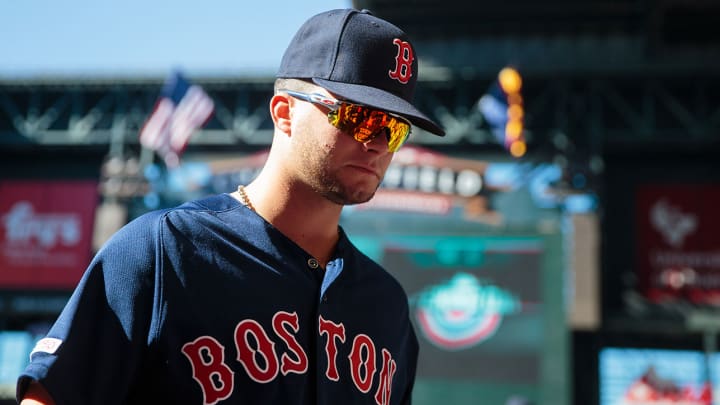The Royals Are Betting Andrew Benintendi Will Bounce Back

Red Sox chief baseball officer Chaim Bloom did not draft Andrew Benintendi. He had no emotional investment in the player. What he saw were declining metrics on Benintendi. He was getting slower. He was striking out more.
What he saw in Franchy Cordero were metrics to dream on. He hits the ball hard. He runs fast.
The three-way trade among the Red Sox, Royals and Mets is, at its core, a swap of 26-year-old left-handed hitting outfielders. That the Royals preferred Benintendi and the Red Sox preferred Cordero is a reflection of the ethos of each team. The Royals needed a ready-made left-handed bat for a team they believe will contend for a playoff spot this year. Benintendi is their new Alex Gordon.
Under Bloom, the Red Sox are in full Rays mode: They sold low on the better major league player (and kicked in $2.8 million) out of belief that Cordero’s metrics suggest he could wind up being the better major league player and they are willing to wait.
Bloom has made this bet before with the Rays. For months in 2017–18 he coveted Cleveland's Yandy Díaz because of his hard-hit rate. “Any time you get a guy who hits the ball really hard,” he said then, “there’s always additional upside to the extent they can drive the ball a little bit.” The core belief is that hard-hit rate is a precursor to more power that can be unlocked with a change in approach or swing.
Bloom traded first baseman Jake Bauers to Cleveland to get Díaz in December 2018. Many eyebrows were raised when Bloom traded Bauers, who was thought to be a key part of the team. But Bloom won the trade. His belief in hard-hit rate was rewarded. Díaz’s power spiked in 2019, though it did regress in the shortened 2020 season.
Like Díaz, Cordero hits the ball hard, but not often enough and not in the air enough. He is a project. He is strong but hits too many grounders. He is fast but is not an elite base stealer. He is a showcase player: a guy with great tools who hasn’t yet translated them consistently in game play. Bloom is interpreting the metrics to think Cordero is headed up and Benintendi is headed down.
The Royals preferred the surer outfielder, Benintendi, especially at a cost of only $3.8 million. Kansas City is emboldened by the scouting background of Dayton Moore, who knows that a proven elite hit tool on the big league level just doesn’t disappear at age 26–not without underlying injury.
Benintendi has been a gifted hitter since college. At age 23 he hit 41 doubles (thanks, Fenway) and posted an .830 OPS and 123 OPS+ for a world championship team. Then the decline happened, a decline so odd that his sprint speed has slowed in each of the past four seasons.
What happened? Benintendi needs to commit to a foundation of who he is as a player. He has vacillated between body types (bulking up, leaning out), approaches (pull more, pull less) and set-ups (open stance, more neutral stance). In his brief and disastrous season last year Benintendi looked as if he were trying to channel Cody Bellinger. He brought his feet closer together, dumped his open stance and tamped down his pre-swing rhythm.
Very broadly, there are two types of hitters: hitters that flow and hitters that explode. The ones that flow rely on an early start and the timing of the kinetic chain of hitting (i.e. Mookie Betts, Josh Donaldson, Justin Turner, Christian Yelich). Hitters that explode (i.e. Bellinger, Giancarlo Stanton, J.D. Martinez, Corey Seager) wait longer to start, then fire their swing in a burst. With his open stance and leg kick, Benintendi is a natural flow kind of hitter. I would anticipate the Royals get him back to that point.
It is rare to find a player who loses his hit tool at age 25 and never gets it back. The best case study analogous to Benintendi is left-handed-hitting Darin Erstad, who also had a terrible season at age 25 (.255, 74 OPS+) for the Angels. Their lifetime statistics to that point are eerily similar. Benintendi (51 HR, 260 RBI, .273 average, .435 slug) looks a lot like Erstad (52, 232, .282, .433). At age 26, Erstad not only returned to form, he hit .355 with 240 hits.
Benintendi is not about to get 240 hits, but he is likely to bounce back. It’s a fascinating trade in which the Red Sox and Royals each wound up with a 26-year-old outfielder who better serves their needs. The Royals are making the safer bet.

Tom Verducci is a senior writer for Sports Illustrated who has covered Major League Baseball since 1981. He also serves as an analyst for FOX Sports and the MLB Network; is a New York Times best-selling author; and cohosts The Book of Joe podcast with Joe Maddon. A five-time Emmy Award winner across three categories (studio analyst, reporter, short form writing) and nominated in a fourth (game analyst), he is a three-time National Sportswriter of the Year winner, two-time National Magazine Award finalist, and a Penn State Distinguished Alumnus Award recipient. Verducci is a member of the National Sports Media Hall of Fame, Baseball Writers Association of America (including past New York chapter chairman) and a Baseball Hall of Fame voter since 1993. He also is the only writer to be a game analyst for World Series telecasts. He lives in New Jersey with his wife, with whom he has two children.